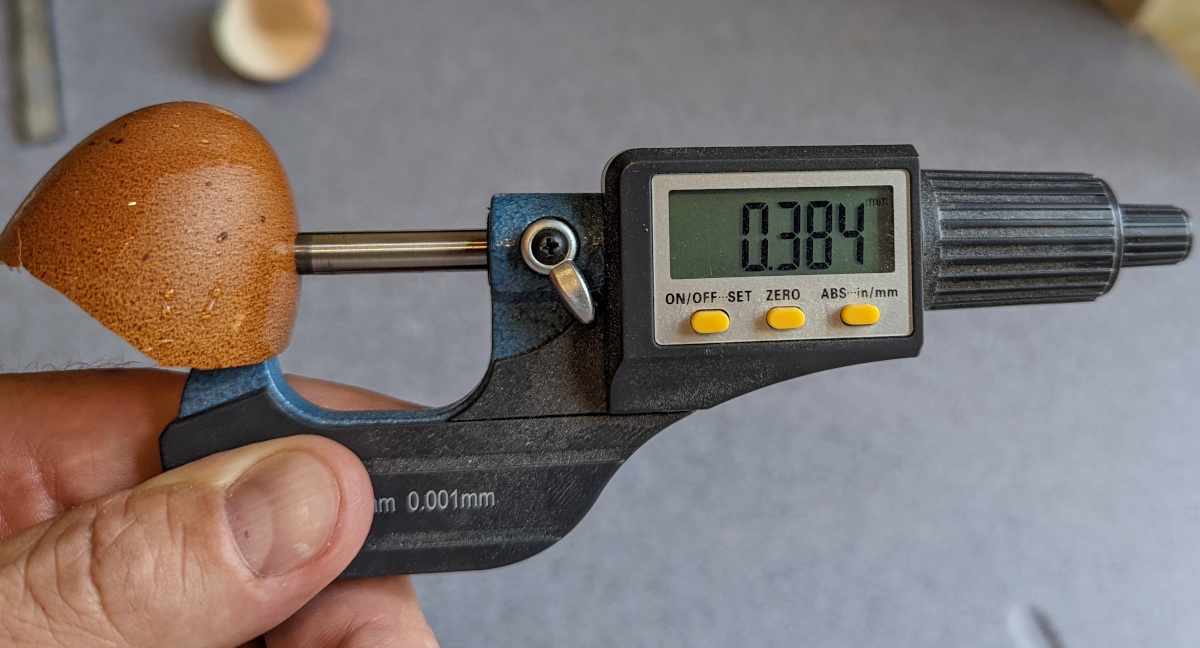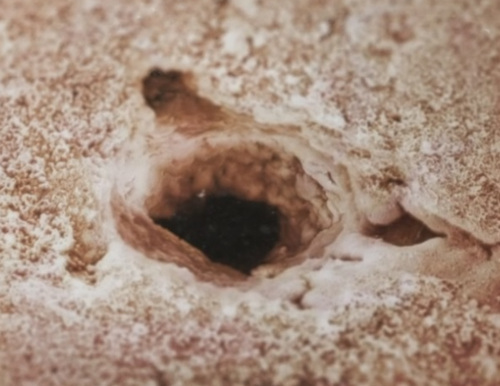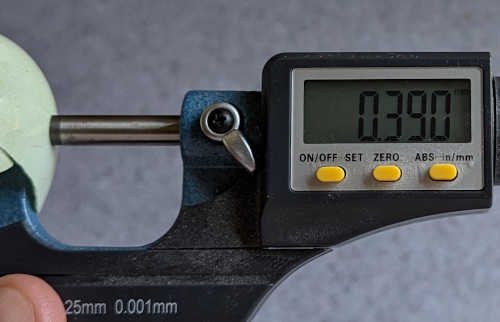Thickness and strength of eggshells and why it matters.

Egg shell thickness and quality is very important, in the commercial egg industry more than 50% of discarded chickens eggs are because of shell problems.
In our recent egg testing series when I bought nearly 2000 eggs from backyard keepers and hatching eggs suppliers, I found that close to 7% of all the eggs had shell problems.
Table of Contents
- How strong is an eggshell?
- How do you measure the strength of eggshells?
- What determines the strength and thickness of eggshells?
- What is the importance of egg shell thickness?
- What affects egg shell thickness and strength?
- Egg shell thickness by poultry species:
- How to measure egg shell thickness and quality?
- How much does egg shell thickness vary?
I tested 21 types of eggs and their shells from 16 types of poultry and the thickness ranged from 0.255 mm for the quails egg to 1.912 mm for the ostrich egg.
The thickness of the egg shell is relative to the size of the egg, the smallest eggs generally have the thinnest shells. The exception to this rule is the Guinea fowl.
How strong is an eggshell?
I have measured the strength of all the eggshells from Quail to Goose, we tried Emu, Ostrich and Rhea but the egg shells were to strong for our equipment to test.
Eggshells are strong because of their shape and can bear much more force down their long axis than they can at their equator. It also requires one quarter as much force to get out of an egg shell than into it which explains why chicks hatch so easily.
The various chicken eggs I tested required a force between 26 N and 48.6 N to break the shell depending on the breed and egg shell colour.
There is no universal industry standard for the testing of egg shell strength but it is widely accepted that eggs need to withstand a force of 35 Newtons or 3.5 kgf (kilogram-force) to survive shipping and handling.
Table of results for eggshell strength testing:
| Species / egg type. | Force in Newtons required to break the shell. |
| Celedon Quail | 12.9 N |
| Quail. | 13.5 N |
| Partridge. | 23.6 N |
| Pheasant. | 29.8 N |
| Guinea fowl. | 36.3 N |
| True Bantam chicken (Serama). | 26.0 N |
| Bantam chicken egg. | 29.1 N |
| Blue egg chicken. | 48.6 N |
| Brown Egg heritage breed. | 37.0 N |
| Hybrid chickens egg (store bought). | 25.9 N |
| Duck. | 29.0 N |
| Turkey. | 54.7 N |
| Peafowl. | 85.3 N |
| Goose. | 181.9 N |
| Rhea. | < 500 N |
| Emu. | < 500 N |
| Ostrich. | < 500 N |
The strength testing shows that green and blue eggs are the strongest chicken eggs with brown next strongest and white the next, store bought hybrid eggs were the weakest on test.
How do you measure the strength of eggshells?
Eggshell strength is measured by testing the shell of a fresh egg to destruction with a force gauge. The force is applied with s plate to the pointed end of the shell and the peak force required to break the shell is measured.
Below: Here I am demonstrating the procedure for testing the strength of an eggshell.
Video transcript: Today we are going to measure the strength of eggshells with a force gauge. So we are going to set the gauge to zero, then peak because we need to measure the peak force when the shell gives way. Then keep applying force until the shell gives way and in this example we get 37 Newtons. That shows how much force it takes to break an egg.
What determines the strength and thickness of eggshells?
Strength is determined by three primary factors, the age of the hen, the thickness of the shell and size of the pores in the shell. Diet, breed and farming practices also have an indirect bearing on shell thickness and quality.
There are between 8,000 and 15,000 tiny pores in the shell that in a typical chickens egg add up to 1.8 mm² of the surface. If there are too many or they are too big it will effect the strength of the egg shell.
Below: These pores allow oxygen, carbon dioxide and moisture to pass through and keep bacteria out.

For chickens, thin shells are between 0.28 and 0.30 mm, medium shells are between 0.30 and 0.36 mm and thick shells are between 0.39 and 0.41 mm.
Below: Large eggs like this Ostrich egg have thicker shells at nearly 2 mm. I had to break this one with a hammer.

The thickness of the shell of an egg is determined by the species, the diet, the size of bird and the amount of time the egg spends inside the shell gland as well as the rate of calcium deposition during shell formation.
What is the importance of egg shell thickness?
Egg shells protect the contents and keep pathogens out and eggs with shells less than 0.28 mm thick rarely hatch viable chicks due to excessive dehydration during incubation.
Thicker eggshells are better but only too a point. There is a certain thickness of shell that protects the contents but still allows the chick to hatch easily.
If the shell were too thick, the chick would be unable to hatch and that would be a disaster for the continuity of the species.
What affects egg shell thickness and strength?
Some eggs shells are thinner because as the hen gets older, egg weight increases and shell thickness decreases.
Below: Blue and green shelled eggs had consistently thicker shells by around 0.04 mm.

Egg shells vary in thickness relative to the amount of contents they contain. The more the egg needs to hold, the thicker the shell needs to be.
Factors that effect shell thickness and strength:
- The age of the hen
- The diet of the chicken that laid the egg
- The size and number of pores in the shell
- How the chicken is kept. Confined birds have thinner shells
- The breed
- The size of the egg
Egg shell thickness by poultry species:
| Poultry species: | Egg shell thickness in mm: |
| Celedon Quail | 0.255 mm |
| Quail. | 0.371 mm |
| Partridge. | 0.277 mm |
| Pheasant. | 0.344 mm |
| Guinea fowl. | 0.657 mm |
| True Bantam chicken (Serama). | 0.362 mm |
| Bantam chicken. | 0.384 mm |
| Orpington chicken. | 0.401 mm |
| Hybrid chickens egg (store bought). | 0.338 mm |
| Duck. | 0.466 mm |
| Turkey. | 0.560 mm |
| Peafowl. | 0.675 mm |
| Goose. | 0.550 mm |
| Rhea. | 1.197 mm |
| Emu. | 1.336 mm |
| Ostrich. | 1.912 mm |
How to measure egg shell thickness and quality?
Egg shell thickness is measured with a micrometer.
Below: This video shows how I measure egg shell thickness and quality.
Video transcript: This is how we measure egg shell thickness. I use a micrometer and you can see from this piece of Ostrich eggs that is 1.913 mm thick, or just under two millimetres thick. If we go all the way down to Celedon quails egg you can see that it is 0.26 mm thick.
To evaluate shell thickness and quality carefully break the egg, discard contents and carefully rinse shell in water.
Peel the membranes away from the shell and then allow the eggshells to dry overnight.
Use a curved pin micrometer to measure the thickness of the shell in three places, the top, middle and bottom of the egg.
The average of the three measurements will give you shell thickness. Wildly variable measurements indicate and egg shell quality issue.
How much does egg shell thickness vary?
Egg shells show remarkable variability, I tested hundreds of chickens eggs from store bought through bantams and a mix of breeds and we found chicken egg shell thickness varied from 0.245 mm to 0.550 mm depending on the breed and how it is farmed.
The thinnest egg we tested was from a Celedon quail and it had a shell thickness of 0.191 mm. The thickest egg shell we tested was the Ostrich at 2.040 mm.
Different areas of the eggshell had different thickness, sometimes by as much as 7%.
I found Eggshells are thinner in the middle and thicker at the ends with the pointed end being the thickest shell on almost all the eggs we tested. The biggest single difference we measured was 0.031 mm and the average was 0.019 mm.
Some egg shells seem harder than others because they are thicker, have a stronger protein matrix and less or smaller pores in the shell.
Thin shelled eggs are safe to eat provided the shell is still intact. They will spoil more quickly than normal eggs.
